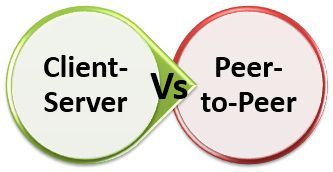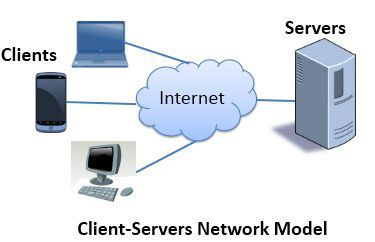 Working on computers for long you may have heard the terms Client-Server and Peer-to-Peer. These two are the common network models that we use in our day-to-day life. The Client-Server network model focuses on information sharing whereas, the Peer-to-Peer network model focuses on connectivity to the remote computers.
Working on computers for long you may have heard the terms Client-Server and Peer-to-Peer. These two are the common network models that we use in our day-to-day life. The Client-Server network model focuses on information sharing whereas, the Peer-to-Peer network model focuses on connectivity to the remote computers.
The main difference between the Client-Server and Peer-to-Peer network model is that in Client-Server model, the data management is centralised whereas, in Peer-to-Peer each user has its own data and applications. Further, we will discuss some more differences between Client-Server and Peer-to-Peer network model with the help of comparison chart shown below, just have a look.
Content: Client-Server Vs Peer-to-Peer
Comparison Chart
| Basis for Comapaison | Client-Server | Peer-to-Peer |
|---|---|---|
| Basic | There is a specific server and specific clients connected to the server. | Clients and server are not distinguished; each node act as client and server. |
| Service | The client request for service and server respond with the service. | Each node can request for services and can also provide the services. |
| Focus | Sharing the information. | Connectivity. |
| Data | The data is stored in a centralized server. | Each peer has its own data. |
| Server | When several clients request for the services simultaneously, a server can get bottlenecked. | As the services are provided by several servers distributed in the peer-to-peer system, a server in not bottlenecked. |
| Expense | The client-server are expensive to implement. | Peer-to-peer are less expensive to implement. |
| Stability | Client-Server is more stable and scalable. | Peer-toPeer suffers if the number of peers increases in the system. |
Definition of Client-Server
The Client-Server network model is widely used network model. Here, Server is a powerful system that stores the data or information in it. On the other hands, the Client is the machine which let the users access the data on the remote server.
 The system administrator manages the data on the server. The client machines and the server are connected through a network. It allows the clients to access data even if the client machine and server are far apart from each other.
The system administrator manages the data on the server. The client machines and the server are connected through a network. It allows the clients to access data even if the client machine and server are far apart from each other.
In Client-Server model, the client process on the client machine sends the request to the server process on the server machine. When the server receives the client request, it lookouts for the requested data and send it back with the reply.
As all the services are provided by a centralized server, there may be chances of server getting bottlenecked, slowing down the efficiency of the system.
Definition of Peer-to-Peer
Unlike Client-Server, the Peer-to-Peer model does not distinguish between client and server instead each node can either be a client or a server depending on the whether the node is requesting or providing the services. Each node is considered as a peer.
 To become a part of peer-to-peer, a node must initially join the network. After joining it must start to provide services to and must request the services from other nodes in the peer-to-peer system. There are two ways to know which node provides which services; they are as follow:
To become a part of peer-to-peer, a node must initially join the network. After joining it must start to provide services to and must request the services from other nodes in the peer-to-peer system. There are two ways to know which node provides which services; they are as follow:
- When a node enters the peer-to-peer system, it must register the services it will be providing, into a centralized lookup service on the network. When a node desires for any specific service it must contact centralized lookup services to check out which node will provide the desired services. Rest of the communication is done by the desiring node and the service providing node.
- A node desiring for the specific services must broadcast the request for services to all other nodes in the peer-to-peer system. The node providing the requested service will respond to the node making the request.
Peer-to-Peer network has the advantage over client-server that the server is not bottlenecked as the services are provided by the several nodes distributed in a peer-to-peer system.
Key Differences Between Client-Server and Peer-to-Peer Network
- The key difference between Client-Server and Peer-to-Peer network is that there is a dedicated server and specific clients in the client-server network model whereas, in peer-to-peer each node can act as both server and client.
- In the client-server model, the server provides services to the client. However, in peer-to-peer, each peer can provide services and can also request for the services.
- In the client-server model, sharing information is more important whereas, in peer-to-peer model connectivity between peers is more important.
- In the client-server model, data is stored on a centralized server whereas, in peer-to-peer each peer has its own data.
- In peer-to-peer model, the servers are distributed in a system, so there are fewer chances of server getting bottlenecked, but in the client-server model, there is a single server serving the clients, so there are more chances of server getting bottlenecked.
- The client-server model is more expensive to implement than peer-to-peer.
- The client-server model is more scalable and stable than peer-to-peer.
Conclusion
It depends on the environment which network model to implement; each model has its own strength and flaws.
Saki says
Good job on the article!
davo says
Thank you, mam.
madan says
sure a nicely written article. thank you
Dramani Rophine says
so nice article.
smitty says
Good article.
Ravi says
Nice
Steve Jobs says
I like this content…
Teshani says
Great article with very clear information.Thank you!
Abdihamid says
Great article, thank you…
yousuf says
Nice, thanks for the information it really helped
WOW says
I surely liked this article because it helped me in my IT-lesson this morning, NICE
bibesh says
nice
Vlad says
Wow thanks this article is really clear and understandable
Mary Jane Cenizal says
Thank you for the information I will use it for the explanation of both architecture in my class, Simple explanation and easy to understand. Good job!
compuetrcargo says
great content ….nice to visit your website
Anish Kumar says
Thanks mam
Ritovash Banerjee says
You have shared a very informative article. I loved your work. in future, I would like to read more articles like this from you.
Rob says
The main reason why I only use P2P (Utopia ecosystem) is the lack of servers where all my personal information will be stored.